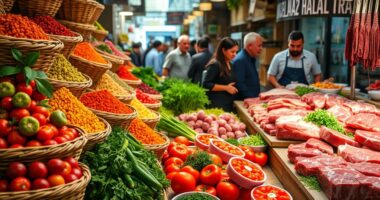When traveling in the Middle East, you should try juicy kebabs and smoky grilled meats seasoned with spices like cumin and coriander. Don’t miss hearty stews and fragrant rice dishes that simmer slowly for deep flavor. Enjoy flavorful mezzes such as hummus, stuffed grape leaves, and fresh vegetable platters. Finish with sweet pastries like baklava and knafeh soaked in honey. For a true taste of the coast, sample fresh seafood like grilled hammour or shrimp shawarma. Explore more to uncover even richer flavors.
Key Takeaways
- Savor juicy grilled kebabs and shawarma, marinated with spices and cooked to smoky perfection.
- Try traditional stews like tagine or pilaf, featuring tender meats and fragrant herbs.
- Sample diverse mezzes such as hummus, stuffed grape leaves, and vegetable platters for a flavorful appetizer experience.
- Indulge in honey-soaked pastries like baklava and knafeh, showcasing regional pastry craftsmanship.
- Enjoy fresh seafood dishes like grilled Hammour and Sayadiya, highlighting coastal culinary traditions.
Juicy Kebabs and Grilled Meats
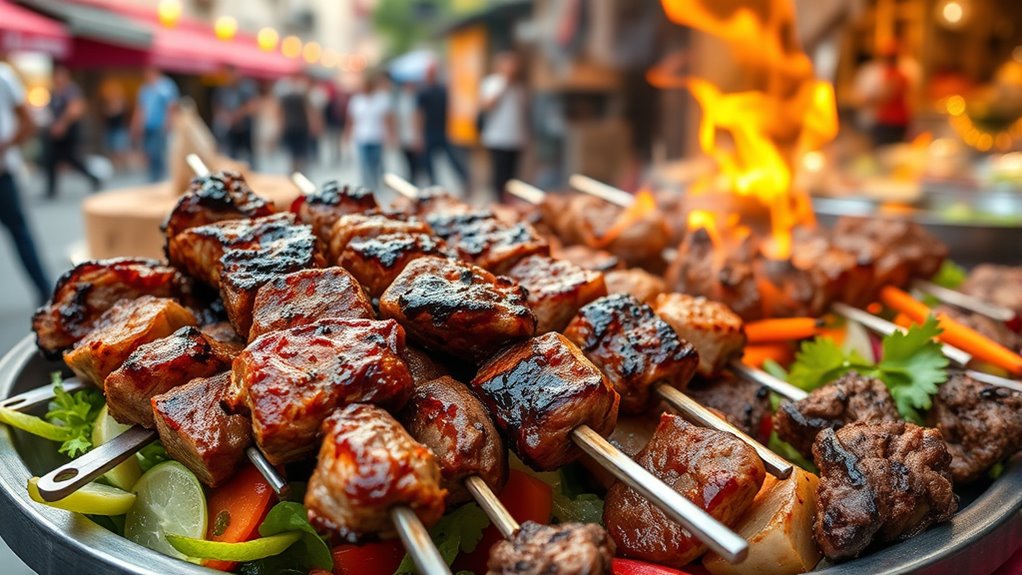
When traveling through the Middle East, you’ll find that juicy kebabs and grilled meats are everywhere, offering a delicious taste of local cuisine. Lamb skewers are a staple, marinated with spices and grilled to perfection, delivering smoky, tender bites. You’ll also encounter spicy shawarma, where thin slices of meat are seasoned with flavorful blends and cooked on vertical rotisseries, creating mouthwatering aromas. These dishes are often served with fresh flatbreads, vegetables, and tangy sauces, making them perfect for a quick, satisfying meal. The emphasis on high-quality halal meats guarantees you get authentic flavors while respecting dietary preferences. Proper storage in airtight containers preserves freshness and ensures the meats remain flavorful. Whether enjoyed at bustling street stalls or local restaurants, these grilled meats embody the vibrant culinary culture of the Middle East.
Traditional Stews and Rice Dishes
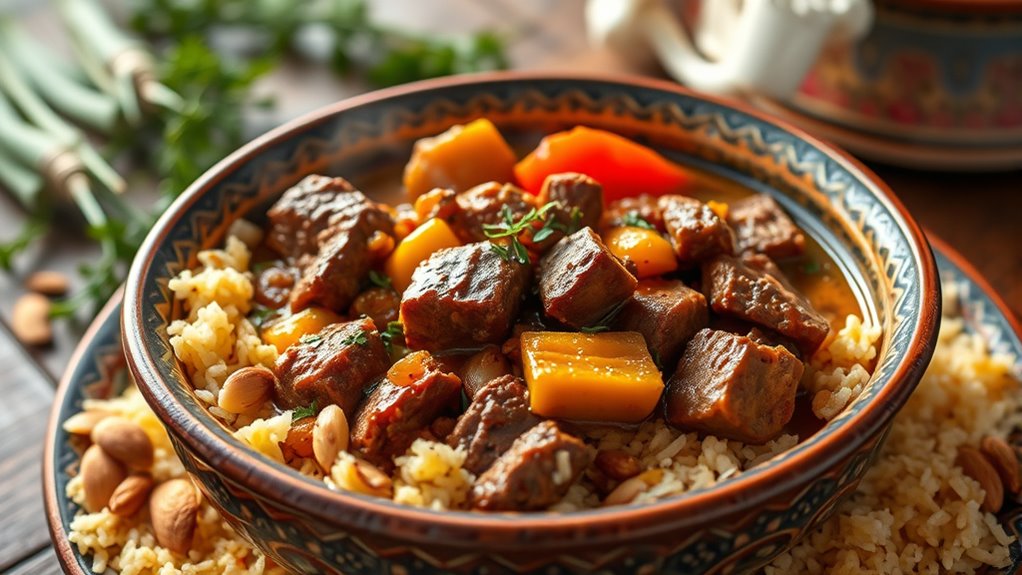
Traditional stews and rice dishes are the heart of Middle Eastern comfort food, offering rich flavors and hearty textures. When preparing these dishes, you’ll notice the importance of cooking techniques like slow simmering, which develops deep flavors, and proper ingredient sourcing, ensuring fresh herbs, spices, and quality meats. These elements come together in dishes like pilafs and hearty stews, which often feature tender meats, vegetables, and fragrant rice. To replicate authentic flavors, focus on sourcing spices like cumin, coriander, and cinnamon, and using traditional methods such as layering spices early in cooking. Proper cooking techniques are essential to achieve the depth of flavor characteristic of these dishes, and understanding ingredient sourcing plays a vital role in authentic preparation. Incorporating authentic ingredients can elevate the dishes and bring out the true essence of Middle Eastern cuisine.
Flavorful Mezzes and Appetizers
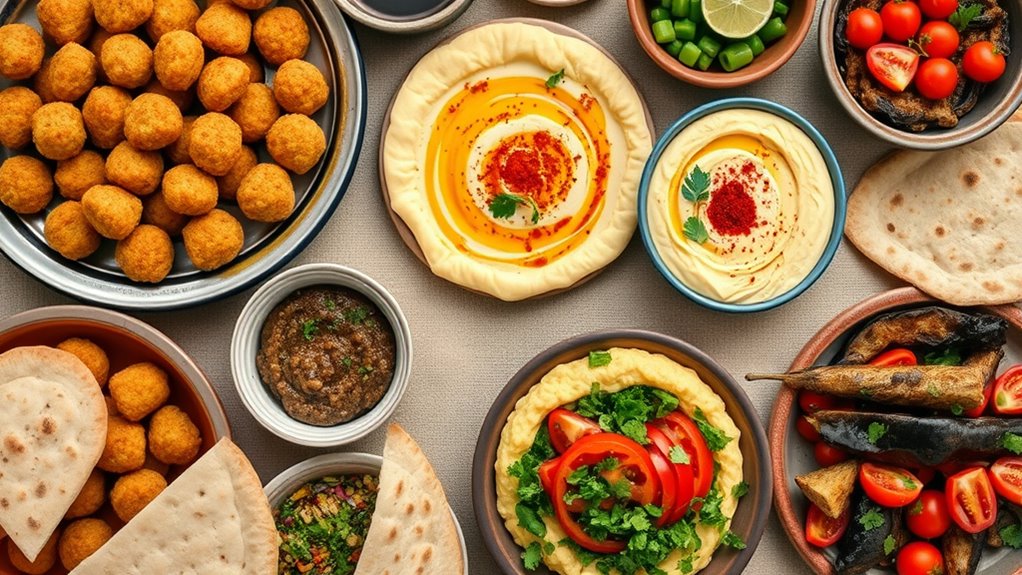
When you start exploring Middle Eastern cuisine, you’ll notice a variety of flavorful mezzes and appetizers waiting to be enjoyed. Classic hummus variations, fresh vegetable platters, and stuffed grape leaves are popular choices that showcase vibrant flavors. These dishes are perfect for sharing and give you a true taste of the region’s culinary diversity. Incorporating color accuracy like decorative serving trays and table linens can enhance your dining experience.
Classic Hummus Variations
Hummus is a staple in Middle Eastern cuisine, and its versatility shines through in countless variations that serve as flavorful mezze and appetizers. You’ll find hummus topped with a variety of ingredients, from olive oil and paprika to chopped herbs and pine nuts, adding richness and texture. Don’t miss out on vegan hummus options that incorporate roasted red peppers, sun-dried tomatoes, or spicy harissa for bold flavors. These toppings not only enhance taste but also showcase regional twists. Whether you prefer a classic smooth hummus or one with a chunky, flavorful topping, each variation offers a new way to enjoy this beloved dish. Exploring these hummus variations lets you experience the culinary diversity of the Middle East in every bite.
Fresh Vegetable Platters
Fresh vegetable platters are a vibrant and healthy addition to any Middle Eastern mezze spread. They showcase the beauty of organic farming, highlighting crisp, farm-fresh produce. To elevate your presentation, use food presentation techniques like colorful arrangement and garnishing with herbs. Here are three must-try options:
- Cucumbers and Cherry Tomatoes – arranged in contrasting colors for visual appeal.
- Carrot and Bell Pepper Sticks – sliced uniformly, highlighting freshness.
- Radishes and Pickles – adding a tangy crunch that complements other veggies.
These platters not only satisfy hunger but also reflect the region’s emphasis on fresh, organic ingredients. Their vibrant appearance makes them perfect for sharing, enhancing your mezze experience with healthy, eye-catching options.
Flavorful Stuffed Grape Leaves
Flavorful stuffed grape leaves are a staple in Middle Eastern cuisine, offering a perfect balance of savory rice, herbs, and sometimes minced meat wrapped tightly in tender grape leaves. These stuffed grape leaves are a classic Mediterranean appetizer, often served as part of a mezze platter. When you try them, you’ll notice the tang of lemon juice and the aromatic herbs that enhance their flavor. They’re typically cooked in a light broth or olive oil, making each bite tender and flavorful. Whether filled with just rice or a combination of rice and seasoned meat, stuffed grape leaves deliver a satisfying taste of Middle Eastern tradition. They’re a must-try dish that beautifully combines freshness and rich flavors, perfect for sharing or beginning your culinary journey through the region.
Sweet Pastries and Desserts

When you explore Middle Eastern sweets, you’ll notice a variety of traditional pastries that are both delicious and unique. Many of these treats are soaked in honey and feature rich, flaky layers that melt in your mouth. These desserts offer a perfect ending to your meal, showcasing authentic flavors that have been enjoyed for generations.
Traditional Pastry Varieties
Traditional pastry varieties in the Middle East offer a rich array of sweet treats that are both delicious and culturally significant. You’ll find an impressive selection of desserts that showcase local flavors and techniques. Here are three must-try options:
- Baklava varieties—layered, flaky pastries filled with nuts and soaked in honey or syrup, each region offering its unique twist.
- Knafeh desserts—soft, creamy cheese or semolina-based treats topped with crispy pastry shreds and drizzled with syrup for a perfect balance of sweet and savory.
- Maamoul cookies—stuffed with dates, nuts, or figs, these melt-in-your-mouth pastries are often enjoyed during special occasions.
These desserts highlight the artistry and rich culinary traditions of the Middle East, promising a delightful experience.
Rich, Honey-Drizzled Treats
Many Middle Eastern desserts are famous for their rich textures and sweet, honey-glazed finishes. You’ll find honey-infused desserts that highlight the region’s mastery in balancing sweetness and flavor. These treats often feature golden syrup, giving them a luscious shine and irresistible aroma. You might try baklava, layered with nuts and drenched in honey, or knafeh, with its gooey cheese filling topped with honey and pistachios. These golden syrup treats melt in your mouth, offering a perfect blend of crunch and softness. When you indulge in these desserts, you experience the region’s love for sweet, honey-drizzled delicacies that are both visually stunning and delightfully satisfying. Incorporating fermentation techniques can also enhance the depth of flavor in traditional desserts, and some recipes have been refined over generations to achieve a more complex taste profile. As the region’s culinary traditions evolve, some modern recipes incorporate sourdough fermentation to develop richer, more complex tastes. Don’t miss out on these rich, honey-infused treats during your Middle Eastern adventure.
Fresh Seafood Delights
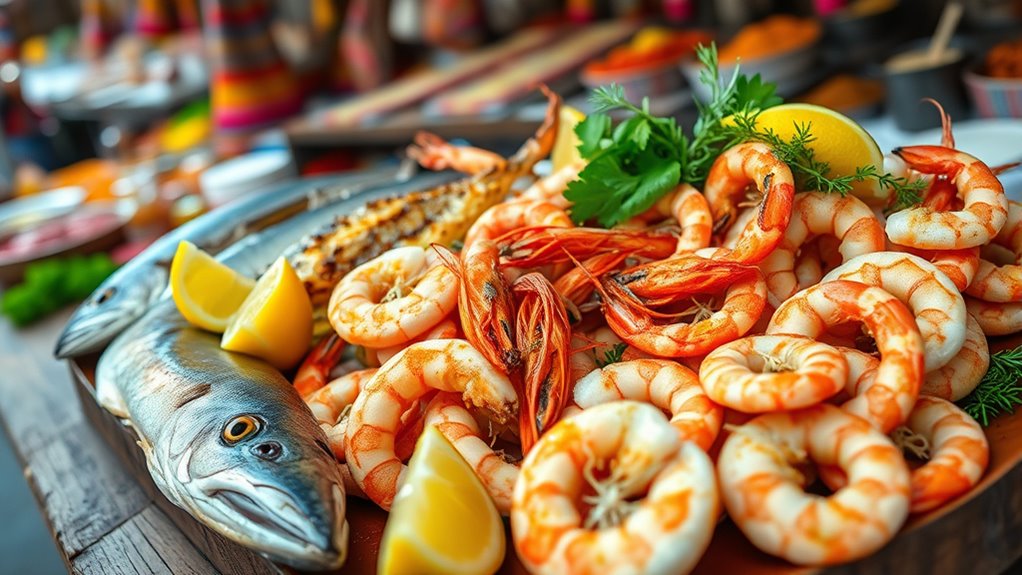
Exploring the Middle East offers a fantastic opportunity to indulge in its fresh seafood delights. You can visit bustling seafood markets, where the catch of the day is displayed fresh from the ocean. For a memorable experience, try oceanfront dining, where you can enjoy your meal with stunning coastal views. Here are three must-try seafood dishes:
- Grilled Hammour – tender and flavorful, often seasoned with Middle Eastern spices.
- Sayadiya – a fragrant fish and rice dish, perfect for sharing.
- Shrimp Shawarma – spicy, marinated shrimp wrapped in pita, offering a delicious twist on classic street food.
Whether you prefer markets or seaside restaurants, these options showcase the region’s rich maritime bounty and halal culinary tradition. Fresh seafood is a cornerstone of Middle Eastern coastal cuisine, highlighting the region’s connection to the sea and its commitment to halal dietary standards. Additionally, understanding local culinary traditions can enhance your dining experience and appreciation of authentic flavors. Recognizing the importance of cultural food practices can help you better appreciate the region’s unique gastronomic heritage. Incorporating modern food safety techniques ensures that seafood is prepared and served in accordance with health standards, providing a safe and enjoyable dining experience. Being aware of sustainable fishing practices can also contribute to supporting regional ecosystems and responsible consumption.
Iconic Street Food Staples
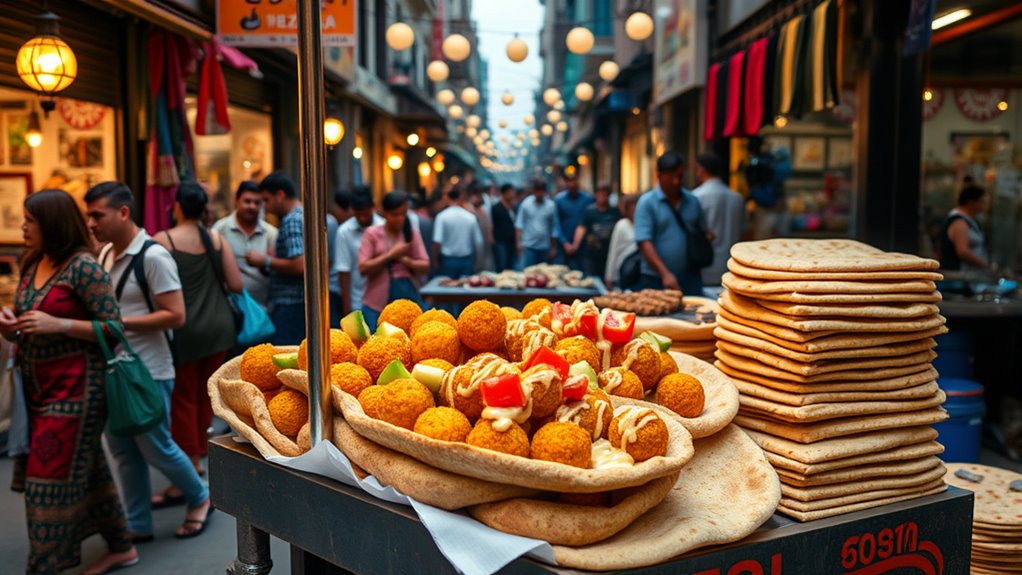
Street food is the heartbeat of Middle Eastern cities, offering quick, flavorful bites that capture the region’s vibrant culinary spirit. You’ll find iconic street food staples like falafel, shawarma, and kebabs, served fresh from bustling stalls and modern food trucks. Fusion street snacks are also gaining popularity, blending traditional flavors with innovative twists, making them perfect for adventurous eaters. These dishes are more than just quick bites; they embody the region’s rich history and diverse influences. Whether you’re grabbing a warm shawarma wrap from a street vendor or trying a contemporary fusion snack from a sleek food truck, these staples give you a true taste of Middle Eastern street cuisine. They’re essential for anyone wanting to experience local flavors on the go. Additionally, understanding the local diverse culinary influences can deepen your appreciation of these iconic dishes. Exploring the cultural significance behind each snack can further enrich your culinary journey, highlighting how food traditions have been preserved and adapted over time. Recognizing the regional variations in preparation and presentation can also enhance your understanding of Middle Eastern food culture. Moreover, learning about food safety practices ensures a safe and enjoyable street food experience.
Frequently Asked Questions
Are All Halal Dishes Suitable for Vegetarians?
Not all halal dishes are suitable for vegetarians, as many include meat or seafood. However, you can find vegetarian substitutes and plant-based options in Middle Eastern cuisine, like falafel, hummus, and grilled vegetables. Always ask about ingredients and look for dishes marked as vegetarian to guarantee they meet your dietary needs. Exploring these options lets you enjoy delicious halal meals without compromising your vegetarian lifestyle.
What Are the Best Halal Wine or Beverage Options?
Imagine sipping a glass of smooth, fragrant halal wine, its rich aroma filling your senses as warm Middle Eastern breezes caress your skin. If alcohol isn’t your preference, explore non-alcoholic beverages like rosewater lemonade or pomegranate juice, vibrant and invigorating. Halal wine options are crafted to meet dietary guidelines, offering a sophisticated alternative. Whichever you choose, these drinks enhance your journey, making every moment in the Middle East truly memorable.
Can I Find Halal Options at Local Markets Easily?
You’ll find halal options at local markets quite easily, thanks to market diversity and ingredient sourcing. Many vendors cater specifically to halal dietary needs, offering a variety of fresh meats, spices, and prepared foods. Just ask vendors about halal certification or look for labels. Exploring markets gives you a genuine taste of local cuisine, ensuring your food choices align with your dietary requirements while enjoying the vibrant atmosphere.
How Do I Identify Authentic Halal Restaurants?
Imagine a beacon guiding your culinary journey—authentic halal restaurants shine through clear Halal certification signs. Look for establishments that prioritize transparent ingredient sourcing, ensuring every dish aligns with halal standards. Ask locals or check online reviews for trusted spots. When you see the halal logo prominently displayed and inquire about ingredient sourcing, you’re sailing smoothly toward a genuine, satisfying meal that respects your dietary needs.
Are Halal Dishes Prepared Differently Across Middle Eastern Countries?
You’ll notice that halal dishes vary across Middle Eastern countries due to regional flavor profiles and cooking techniques. In Lebanon, dishes often feature fresh herbs and lemon, while in Iran, saffron and rice are prominent. In Egypt, you might find hearty stews with spices, and in Turkey, grilled meats are common. Despite these differences, all dishes adhere to halal standards, showcasing the diverse culinary traditions across the region.
Conclusion
Begin your Middle Eastern journey and let these halal dishes be your flavorful compass. Each bite is like a melody, rich with tradition and passion, dancing on your palate. From sizzling kebabs to sweet pastries, you’ll taste the soul of the region in every morsel. So, plunge in with an open heart and let the vibrant spices and warm hospitality sweep you off your feet — this culinary adventure will stay with you long after the last bite.




